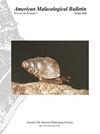DNA Barcoding Permits Identification of Potential Fish Hosts of Unionid Freshwater Mussels
IF 0.4
4区 生物学
Q4 MARINE & FRESHWATER BIOLOGY
引用次数: 11
Abstract
Abstract: Fish have an ecologically significant role in the life-history of unionid freshwater mussels, as the larvae of most species are obligate ectoparasites (glochidia) on fish hosts. Although this ecological interaction is vital to freshwater mussel conservation, there is a paucity of data on fish-host specificity for many species. A species-specific DNA barcoding dataset utilizing the mitochondrial NADH dehydrogenase subunit 1 (ND1) gene was used to identify 154 glochidia attached to wild fish collected from March through August of 2013 in the Sabine and Neches rivers in Texas, U.S.A. These data include the first report of potential hosts for two state-threatened species, Fusconaia askewi (Marsh, 1896) and Pleurobema riddellii (I. Lea, 1862), as well as potential hosts for Amblema plicata (Say, 1817), Obliquaria reflexa (Rafinesque, 1820), Plectomerus dombeyanus (Valenciennes, 1827), Potamilus purpuratus (Lamarck, 1819), Quadrula mortoni (I. Lea, 1831), Q. verrucosa (Rafinesque, 1820), and Truncilla truncata (Rafinesque, 1820). Cyprinella lutrensis appears to be the primary host for F. askewi, as 50% (54/108) of its glochidia were found on this minnow species alone. Pleurobema riddellii may be a cyprinid specialist, infesting only C. lutrensis and Pimephales vigilax. Alternatively, F. askewi may be a host generalist, as glochidia were found encysted on 17 fish species suggesting that host fish availability may not be an important factor contributing to observed population declines. The findings here will be instrumental in the future conservation of these species, through the translocation to correct habitat and developing successful propagation programsDNA条形码允许识别联合淡水贻贝的潜在鱼类宿主
摘要:鱼类在联合淡水贻贝的生活史上具有重要的生态意义,因为大多数物种的幼虫都是鱼类宿主上的专性外寄生虫(glochidia)。尽管这种生态相互作用对淡水贻贝的保护至关重要,但关于许多物种的鱼类宿主特异性的数据却很少。利用线粒体NADH脱氢酶亚基1(ND1)基因的物种特异性DNA条形码数据集,用于识别2013年3月至8月在美国得克萨斯州萨宾河和内奇斯河采集的野生鱼类上附着的154个球壳虫,Fusconaia askewi(Marsh,1896)和Pleurobema riddellii(I.Lea,1862),以及褶皱Amblema(Say,1817)、反射Obliquaria reflectra(Rafinesque,1820)、董贝Plectomerus dombeyanus(Valenciennes,1827)、purpuratus Potamilus(Lamarck,1819)、mortoni Quadrula(I.Lea,1831)、verrucosa Q。卢氏Cyprinella lutrensis似乎是F.askewi的主要宿主,因为其50%(54/108)的glochidia仅在这一鱼类身上发现。丽氏胸蛛可能是一种塞浦路斯专家,只寄生于C.lutrensis和Pimephales nivalax。或者,F.askewi可能是宿主多面手,因为在17种鱼类身上发现了glochidia,这表明宿主鱼类的可用性可能不是导致观察到的种群数量下降的重要因素。这里的发现将有助于这些物种未来的保护,通过迁移到正确的栖息地和制定成功的繁殖计划
本文章由计算机程序翻译,如有差异,请以英文原文为准。
求助全文
约1分钟内获得全文
求助全文
来源期刊
CiteScore
1.00
自引率
40.00%
发文量
1
审稿时长
>12 weeks
期刊介绍:
The American Malacological Bulletin serves as an outlet for reporting notable contributions in malacological research. Manuscripts concerning any aspect of original, unpublished research,important short reports, and detailed reviews dealing with molluscs will be considered for publication. Recent issues have included AMS symposia, independent papers, research notes,and book reviews. All published research articles in this journal have undergone rigorous peer review, based on initial editor screening and anonymous reviewing by independent expertreferees. AMS symposium papers have undergone peer review by symposium organizer, symposium participants, and independent referees.

 求助内容:
求助内容: 应助结果提醒方式:
应助结果提醒方式:


